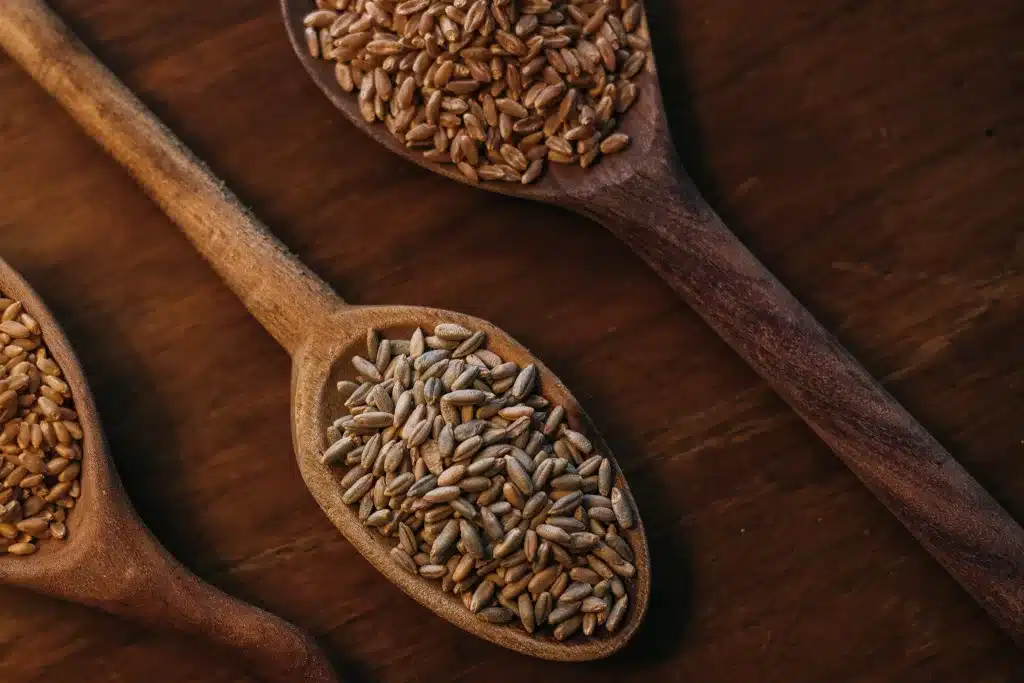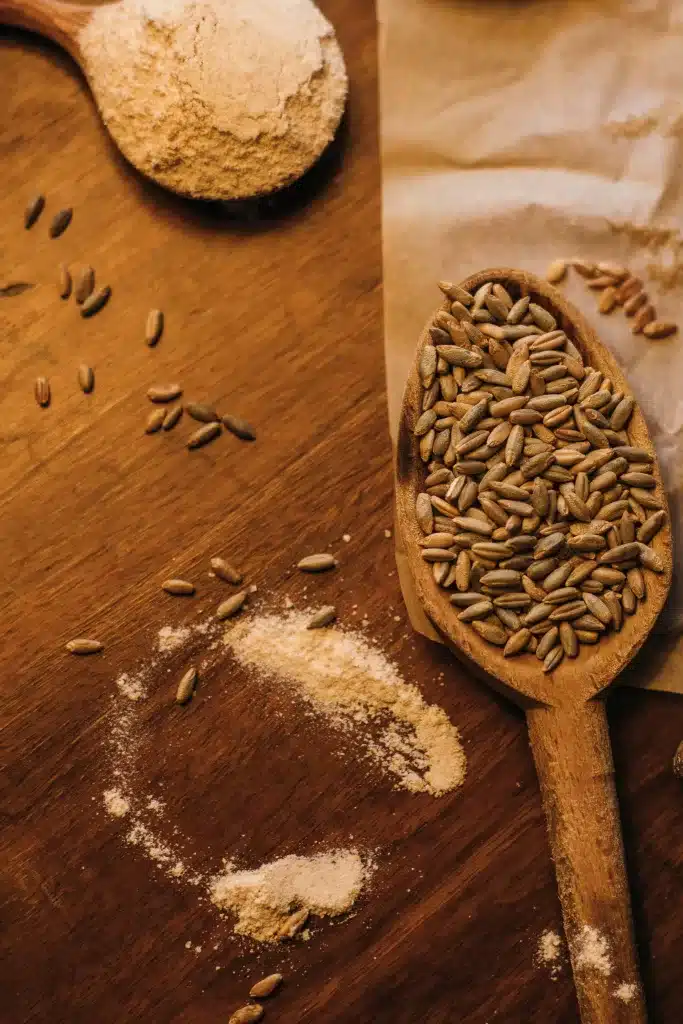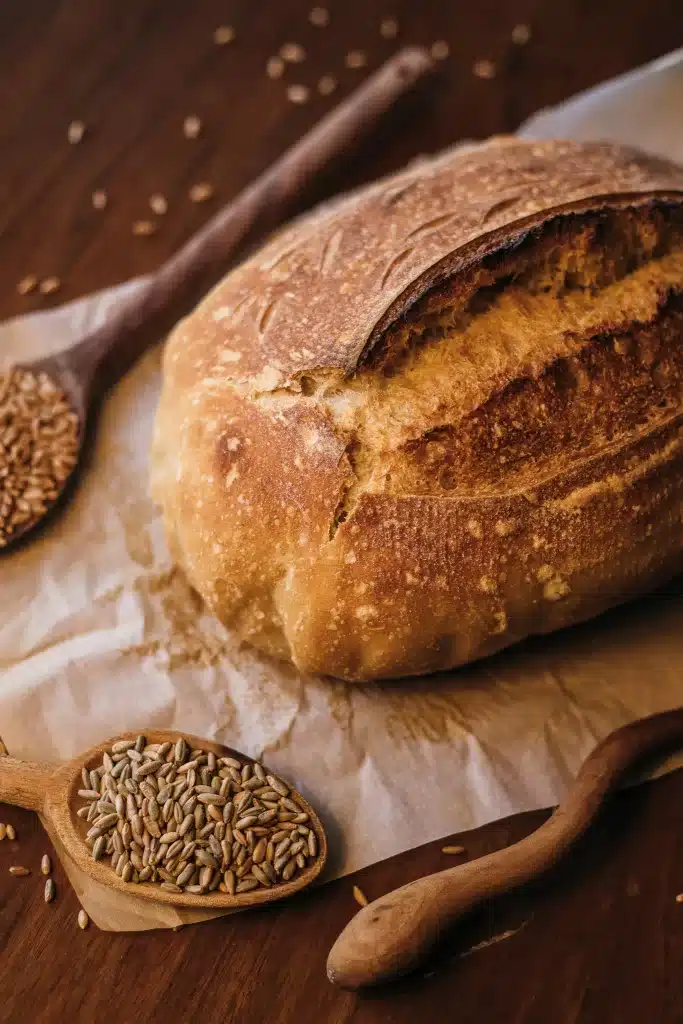
Freshly ground flour is one of those romantic, from scratch, homestead ideas that seems much simpler than it is. How hard can it be to use whole wheat milled flour for sourdough? I remember asking myself when my mom first gave me her old grain mill. The dense, chewy, all-whole wheat yeast loaves of my childhood should have been ample warning that freshly ground flour is not to be trifled with by the naive.
Yet, using my new mill, I mixed up a batch of whole wheat sourdough for the first time, which yielded an underbaked hockey puck. After a short break from the grain mill, I decided to do more research and finally try again after watching videos, listening to podcasts, asking local bakers, and of course some trial and error. Now I am working with freshly ground flour almost every time I bake and the results are delicious and nutritious.
This post may contain affiliate links, which means I make a small commission at no extra cost to you. You can view my Privacy Policy Here.
Anatomy of a wheat berry?
A wheat berry is a grain that is milled into flour. It is composed of three parts: bran, germ, and endosperm. The bran is the part that is usually sifted out of commercial flour. Check out the infographic below for more details.
A Brief history of flour
Before the last 100 years, most communities had a local stone mill where a water wheel supplied the power for large millstones to grind wheat. The finished product was a fresh, flour that included every part of the original wheat berry. This flour might go back to the farmer who brought the grains to be milled, or sold at a local general store. Other more remote families used hand mills to grind their grains. These kinds of practices were very common until a few generations ago when flour, like many other foods, became more “convenient” by adding preservatives, sifting out the bran, and bleaching it. These changes resulted in an inactive, expired, and less nutritious “shelf stable” flour.
Freshly ground flour is not shelf-stable
Flour can quickly expire if it is not stored properly because it does not have any stabilizers like most store-bought flours. This doesn’t mean you will become sick from old flour, it simply means that it will have a much lower nutrient profile. One of the reasons I make sourdough in the first place is to create a living, fermented, dough that is nourishing, so storing freshly ground flour properly is essential.
How to store flour
Always store your flour in the freezer for maximum freshness. I like to grind my flour right before baking, but sometimes I mill more than I need and store that in a jar or bag in the freezer. Wheat berries have been shelf stable for many many years, in fact anthropologists have made bread from ancient wheat berries found in tombs and ruins. I store mine in an airtight bucket in my pantry.


Where to buy freshly ground flour
The best freshly ground flour is grown and milled near you. A quick google search should help you discover dozens of growers and millers nearby. This option is more convenient, but can be expensive in the long run. Because of this, you should do some research, weigh your options, and see what makes the most sense for your area and budget.
Where to buy wheat berries
Wheat berries purchased in bulk will give you the best bang for your buck. You can easily find organic ones for around $1.25 lbs which is much cheaper than I can find high-quality organic flour at the store. I like to visit a local bulk grain store or order mine from Azure Standard.
A key to understanding different kinds of wheat berries
You will see many adjectives used to describe wheat berries: soft, hard, white, red, winter, and spring. These words are all used to communicate the flavor profile, color, protein structure, and season. I have developed a key below to assist you:
Hard: hard wheat berries have a higher protein content and are great for sourdough or conventional yeasted breads. Protein combined with liquid creates gluten which gives us the chewy, stretchy, soft dough we all crave.
Soft: soft wheat berries have a lower protein content which makes them better for bakes that will require additional leavening agents (like baking powder, baking soda, or eggs), think brownies, cookies, cakes, etc. For these kinds of recipes, less protein is better because too much gluten can cause them to be tougher.
White: white wheat berries are lighter in color and flavor. These berries have a milder flavor and are great for pastries, picky eaters, and recipes where you don’t want the flour to compete with other flavors.
Red: red wheat berries are darker in color, will have a heartier, nuttier flavor, and are often a favorite choice for whole-wheat lovers.
Winter: winter berries are planted in the fall, go dormant in the winter, grow in the spring, and are harvested in the summer.
Spring: spring berries are planted in the spring and harvested in the summer.
Buying a mill
I have linked a few of my favorite options for milling your own grains below. I have used both of these machines and love them!
The Nutrimill Harvest uses stones to grind a variety of grains. These kinds of mills can be expensive but are a great investment if you plan on milling more in the future.
This mill is a more affordable option that takes up much less space in your kitchen. A great choice for someone who already owns a stand mixer but doesn’t have much extra storage space. I also love this attachment for learning how to mill and work with homemade flour. Overall, a great introductory tool!
Tips for baking with freshly ground flour
Ratios:
Freshly ground flour can be denser and absorb more water than store-bought white or bread flour. For this reason, I like to add more water as I weigh the dough until it reaches my desired consistency. If you are familiar with sourdough, you will know what consistency to look for. If you are new to the process, I would recommend starting with organic bread flour and learning the sourdough process before milling your own. Check out my super simple overnight sourdough loaf for a great beginner recipe.
Sifting:
If you would like less texture, a lighter color, or reduced whole wheat flavor, you can certainly sift out the bran and freeze it for use in muffins, whole wheat bread, or brown bread. I usually leave it in, especially if I am not doing a 100% whole wheat loaf. My best advice is to experiment with this to learn what flavors and textures you prefer.
Start small:
One of my best tips is to not start with baking a 100% freshly ground flour loaf. As you are learning what ratios of water to flour you need and what flavors you prefer, start with 50% freshly ground and work your way up from there. This will help you to gain confidence and experience with wheat berries. Remember there is nothing wrong with using some conventional flour. I usually prefer a nice mix of home milled and store-bought flour for my loaves.
Hello – I started my sourdough starter and bread milling the flour right away. It was hard to get a good loaf for sure. It was hard to get used to using milled flour in everything because it acts so differently. I have just started to experiment with high protein white flour (store milled) and I was surprised at the texture. I’m glad I pushed thru with the milled wheat first but I did see the huge difference and now know I need to add more water and find the happy point with it. I usually use a combo of half hard red and half hard white. Next I will try the combo half hard red and half store milled as you suggested. Thank you for your help and direction.
Miranda Albert